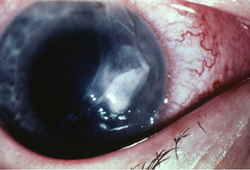Resumen
Diferenciales
Común
- Corneal ulcer
- Dry eye syndrome (tear dysfunction syndrome)
- Dry age-related macular degeneration
- Uveitis/scleritis
- Cataract
- Nondiabetic myopic lens shift
- Wet age-related macular degeneration
- Vitreous hemorrhage
- Retinal venous occlusion
- Retinal arterial occlusion
- Stroke
- Migraine headache or migraine aura without headache (acephalgic migraine)
- Pituitary tumor
- Diabetic retinopathy
- Diabetic myopic lens shift
Infrecuente
- Corneal hydrops
- Traumatic vision loss
- Optic neuritis
- Papilledema
- Leber hereditary optic neuropathy (LHON)
- Acute angle-closure glaucoma
- Retinal detachment
- Postoperative endophthalmitis
- Central retinal artery occlusion
- Pituitary apoplexy
- Arteritic anterior ischemic optic neuropathy/giant cell arteritis
- Nonarteritic anterior ischemic optic neuropathy
- Transient ischemic attack (TIA)
- Cancer-associated retinopathy
Colaboradores
Autores
Jeffrey R. SooHoo, MD, MBA
Associate Professor
Sue Anschutz-Rodgers Eye Center
Department of Ophthalmology
University of Colorado School of Medicine
Aurora
CO
Divulgaciones
JRS declares that he has no competing interests.
Agradecimientos
Dr Jeffrey R. SooHoo would like to gratefully acknowledge Dr Prem S. Subramanian, the previous contributor to this topic.
Divulgaciones
PSS declares that he has no competing interests.
Revisores por pares
Andrew G. Lee, MD
The H. Stanley Neuro-ophthalmology Professor of Ophthalmology, Neurology, and Neurosurgery
The University of Iowa Hospitals and Clinics
Iowa City
IA
Divulgaciones
AGL declares that he has no competing interests.
Robert Avery, MD, PhD
Professor of Ophthalmology
University of New Mexico Medical School
Albuquerque
NM
Divulgaciones
RA declares that he has no competing interests.
Augusto Azuara-Blanco, PhD, FRCS(Ed), FRCOphth
Clinical Senior Lecturer
Health Services Research Unit
University of Aberdeen
Honorary Consultant Ophthalmologist
NHS Grampian
Aberdeen
UK
Divulgaciones
AA-B declares that he has no competing interests.
Stephen Vernon, DM, FRCS, FRCOphth, FCOptom (Hon), DO
Special Professor of Ophthalmology
University of Nottingham
Consultant Ophthalmic Surgeon
Nottingham University Hospitals
Nottingham
UK
Divulgaciones
None declared.
Agradecimiento de los revisores por pares
Los temas de BMJ Best Practice se actualizan de forma continua de acuerdo con los desarrollos en la evidencia y en las guías. Los revisores por pares listados aquí han revisado el contenido al menos una vez durante la historia del tema.
Divulgaciones
Las afiliaciones y divulgaciones de los revisores por pares se refieren al momento de la revisión.
Referencias
Artículos principales
Rossi T, Boccassini B, Iossa M, et al. Triaging and coding ophthalmic emergency: the Rome Eye Scoring System for Urgency and Emergency (RESCUE): a pilot study of 1,000 eye-dedicated emergency room patients. Eur J Ophthalmol. 2007 May-Jun;17(3):413-7. Resumen
Bird AC, Bressler NM, Bressler SB, et al. An international classification and grading system for age-related maculopathy and age-related macular degeneration. Surv Ophthalmol. 1995 Mar-Apr;39(5):367-74. Resumen
Donahue SP, Baker CN; American Academy of Pediatrics; American Association of Certified Orthoptists; American Association for Pediatric Ophthalmology and Strabismus; American Academy of Ophthalmology. Procedures for the evaluation of the visual system by pediatricians. Pediatrics. 2016 Jan;137(1). (Reaffirmed Feb 2022).Texto completo Resumen
Artículos de referencia
Una lista completa de las fuentes a las que se hace referencia en este tema está disponible para los usuarios con acceso a todo BMJ Best Practice.

Folletos para el paciente
Glaucoma
Herpes simplex eye infection
Más Folletos para el pacienteInicie sesión o suscríbase para acceder a todo el BMJ Best Practice
El uso de este contenido está sujeto a nuestra cláusula de exención de responsabilidad